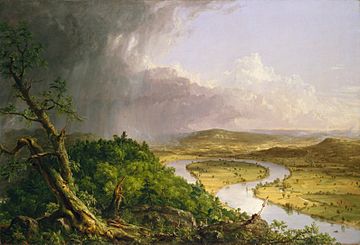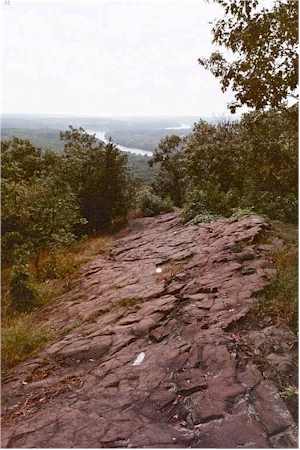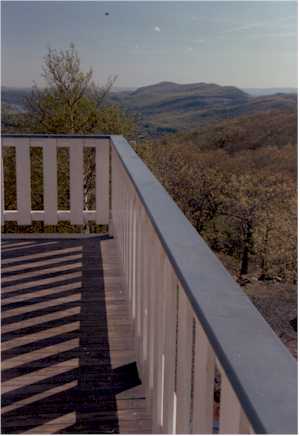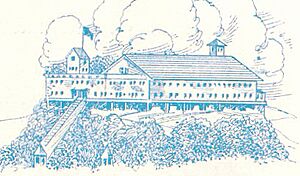Mount Holyoke facts for kids
Quick facts for kids Mount Holyoke |
|
|---|---|

View of the Connecticut River Oxbow from Mount Holyoke summit. 1836 painting by Thomas Cole.
|
|
| Highest point | |
| Elevation | 935 ft (285 m) |
| Geography | |
| Location | Hadley and South Hadley, Massachusetts |
| Parent range | Holyoke Range / Metacomet Ridge |
| Geology | |
| Age of rock | 200 million years |
| Mountain type | Fault-block; igneous |
| Climbing | |
| Easiest route | Auto road |
Mount Holyoke is a mountain in western Massachusetts. It stands about 935 feet (285 meters) tall. This mountain is the westernmost part of the Holyoke Range. It is also part of the 100-mile (160 km) long Metacomet Ridge.
Mount Holyoke is located in the Connecticut River Valley. It sits in the towns of Hadley and South Hadley, Massachusetts. The mountain is famous for its old summit house, a road to the top, and amazing views. It also has many different kinds of plants and animals.
You can find the Metacomet-Monadnock Trail crossing the mountain. This trail is about 110 miles (180 km) long. Mount Holyoke is home to J. A. Skinner State Park. You can reach the park from Route 47 in Hadley.
Contents
Exploring Mount Holyoke's Past
How Mount Holyoke Got Its Name
The mountain is named after Elizur Holyoke. He was an early settler in Springfield, Massachusetts. He explored this mountainous area a long time ago. The city of Holyoke, Massachusetts and Mount Holyoke College are also named after this mountain. They are not directly named after Elizur Holyoke himself.
The Historic Mount Holyoke Summit House
In 1821, a small guest cabin was built on Mount Holyoke. It was one of the first buildings like it in New England. Over the years, the property changed owners. In 1851, it was rebuilt into a two-story hotel with eight rooms.
Local business owners, John and Frances French, owned the hotel for many years. Between 1851 and 1900, they added many improvements. These included a covered tramway to the top of the mountain. At first, horses pulled the tram. Later, it became a machine-powered system. They also built a railroad from the base of the mountain to a steamboat dock.
The Mount Holyoke "Prospect House" became a very popular place for tourists. Guests could take a steamboat to a connecting railway. This railway led to a tramway that went up the mountain. The tram track was first built in 1867. It became electric in 1926.
Other similar hotels were built on nearby mountains. These included Mount Tom and Mount Nonotuck. There were also hotels on Sugarloaf Mountain and Mount Toby.
In the early 1900s, Joseph Allen Skinner bought the Prospect House. He later gave the hotel and land to the state of Massachusetts in 1939. He asked that the park be named after him. Today, it is called J. A. Skinner State Park.
A big storm in 1938 damaged part of the summit house. In 1942, the tramway stopped working. A heavy snowstorm in 1948 caused more damage to the roof. The tram was never fixed and was taken down in 1965. For many years, there wasn't enough money to keep the summit house in good shape. By the 1970s, some people wanted to tear it down. But local people worked hard to save it. In the mid-1980s, the summit house was restored.
Mountain Geology and Ecosystems

How Mount Holyoke Formed
Mount Holyoke is made of a type of rock called basalt. This rock is also known as trap rock. It is a volcanic rock. The mountain formed about 200 million years ago. This happened when the North American continent began to pull away from Africa and Eurasia.
Hot lava came up from cracks in the Earth. It cooled and hardened into thick layers of rock. Later, faulting and earthquakes tilted these rock layers. This created the steep cliffs and ridges you see on Mount Holyoke today.
Unique Plant and Animal Life
The mountain has different types of environments. There are hot, dry slopes at the top. There are cool, wet valleys. There are also rocky ledges rich in minerals. This mix of small environments helps many different plants and animals live here. Some of these species are rare in other parts of Massachusetts.
Fun Activities and Recreation
Exploring the Mountain Trails
The road to the top of Mount Holyoke is open for cars from April to November. The hiking trails are open all year. The Summit House is open on weekends and holidays from Memorial Day to Columbus Day.
Many hiking trails cross the mountain. The most famous are the 110-mile (180 km) Metacomet-Monadnock Trail and the 47-mile (76 km) Robert Frost Trail.
Mount Holyoke College's Mountain Day
Every year in early fall, students from Mount Holyoke College celebrate "Mountain Day." This tradition started in 1838. On a random autumn morning, bells ring from Abbey Chapel. All classes are canceled! Students then hike to the top of Mount Holyoke.
Views and Memorials
The area around the summit house has many picnic tables. There are also trailheads and memorials. One special memorial is for ten men who died in a plane crash. On May 27, 1944, a military transport plane crashed into the side of the mountain. A memorial plaque at the summit remembers this event.
The views from the top of Mount Holyoke are some of the best in Massachusetts. These views have inspired many artists and poets. The nearby Connecticut River Oxbow is a famous bend in the river. The painter Thomas Cole made a famous painting of it in 1836. He sketched it from the top of Mount Holyoke.
From the summit, you can see many places. To the south, you can see the cities of Holyoke, Springfield, and Hartford. To the north, you can see the University of Massachusetts in Amherst. You can also see mountains in Sunderland. To the east is the Holyoke Range and South Hadley. To the west are the foothills of the Berkshires, the Connecticut River, and Northampton.
Protecting Mount Holyoke
Most of Mount Holyoke is part of Skinner State Park. The Mount Holyoke Range State Park is another park. It covers the eastern side of the Holyoke Range. Its visitor center is located where Route 116 crosses the range in Amherst.
In 2000, Mount Holyoke was part of a study. This study looked at creating a new National Scenic Trail. This new trail is now called the New England National Scenic Trail. It would include the Metacomet-Monadnock Trail in Massachusetts. It would also include the Mattabesett Trail and Metacomet Trail in Connecticut.




